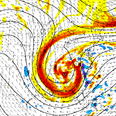-
Posts
5,750 -
Joined
-
Last visited
Content Type
Profiles
Blogs
Forums
American Weather
Media Demo
Store
Gallery
Everything posted by brooklynwx99
-
it’s farther east and at least attempting to get it out of the west, that was the point there also, I don’t think the adage of models being “hot” or “cold” has merit. past performance is not an indication of future success, and the GFS is far away from the consensus, so I have to lean against it if some want to be pessimistic, i get it, but we just have to see things shake out
-
I'm only half kidding, I think this pattern broke the GFS. like what the actual F is this
-
the EPS and GEPS are in absolute lock step agreement with every major pattern feature and then you have the GEFS in left field picking its nose. idk. I can't believe it right now unless the EPS or GEPS make a big shift towards it either way, one camp is going to cave soon. let's hope it's the GEFS
-
it almost always goes towards the OP, though. it's a bad ensemble
-
this is also what I mean. it looks like the GFS is also just having a hard time with the pattern right now and it breaks everything down WAY too fast like wtf is this? this doesn't even have any waves. just a bunch of smattered crap. compare that with the EPS control, which looks like actual weather
-
I'll put it this way. if the GFS/GEFS was the only model showing a favorable outcome and every other model had what the GFS has now, would you believe the favorable outcome? I absolutely would not. it's a game of odds and they're in our favor right now
-
these differences are occurring at like Day 5-6, so this will be resolved over the next couple of days anyway, regardless of the outcome
-
there is definitely a trend here to get the vort out faster, though, regardless of whatever weird way the GFS is thinking of doing it verbatim
-
the relative consistency of the ECMWF / CMC also give me a bit more confidence that they have the right idea. the GFS has been a bit erratic with its handling of the NW US vort
-
yup, exactly... continuing the trends from 12z. block is stronger too
-
looks like a true block as well with a trough stretching from the E US into Europe. kinda like your avatar
-
this pattern looks way different than that one
-
I agree that you can't completely throw it out, but a blind squirrel finds a nut every now and then. I'm sticking with the higher skilled majority as of now
-
not to say it's absolutely, 100% wrong, but a blind squirrel finds a nut every now and then I'm just leaning on the more consistent, higher scoring majority as of now
-
I don't think that's the case. the weather is inherently chaotic and there's no way we could ever figure out how to decipher that chaos more than 5 or so days in advance with any kind of certainty. it's not possible and luck will always play a factor
-
at this point I wouldn't pay much attention to the GFS/GEFS unless the EPS/GEPS move towards it in a significant way. it's on a complete island right now, and the EPS/GEPS became more favorable, if anything. definitely dug their heels in at 12z while the GEFS has been shuffling about... the GFS OP moved towards them in a big way
-
this is nearly perfect. the EPS is holding serve on a legitimate KU evolution for next weekend
-
this is nearly perfect. the EPS is holding serve on a legitimate KU evolution for next weekend
-
this is nearly perfect. the EPS is holding serve on a legitimate KU evolution for next weekend
-
EPS has been trending better and better. stronger -NAO, AK ridging trending more poleward, and a quicker exit of the WC trough. this run looks explosive
-
jesus christ. KU incoming on the ECMWF, no exaggeration
-
ECMWF holding serve, booting the S/W out of the west. the GFS still remains alone here at 12z
-
I know, that's probably the one thing that it's gotten right all by itself this year. usually happens once a year or so. still the worst performing model out of all the globals
-
the GFS usually gets one thing right all year and then flubs as soon as there's an impactful coastal storm. I have seen it so many times it sucked with Monday's system up here anyway so I'm not even sure what people are talking about
-
first off, it's because it's been rather inconsistent, it's underdispersive, and it's outnumbered by the other two ENS I'll put it this way... if the GEFS was the only ENS that was showing a KU setup and the GEPS/EPS were slower or less clear, I would absolutely, 100% guarantee that everyone would discount the GEFS. no question in my mind the whole evolution it shows is also bizarre to me, and I would expect something more like the other two ENS, it just makes more sense in my head. the GEFS solution is not impossible, but I would lean more towards the EPS/GEPS considering they hold the majority and are becoming stronger in their signals, if anything. we'll see what the EPS does in a bit






